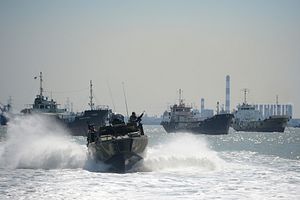This week, reports surfaced that the Indonesian Navy would receive four new drones from the U.S. government. The reports once again put the spotlight on ongoing U.S. attempts to boost the intelligence, surveillance and reconnaissance capabilities of Southeast Asian states to boost maritime domain awareness.
As I have noted before, while the idea of building allied and partner maritime capabilities is far from new, under former U.S. President Barack Obama, Washington had accelerated U.S. maritime security assistance to Southeast Asian states. Though there were various sources of U.S. maritime capacity-building efforts, one of these was the Southeast Asia Maritime Security Initiative (MSI), which allotted $425 million for a number of countries including five main Southeast Asian states – Indonesia, Malaysia, the Philippines, Thailand, and Vietnam – geared towards enhancing regional maritime domain awareness (MDA) (See: “America’s New Maritime Security Initiative“).
Indonesia has been recognized by Washington as a key player within this initiative as well as from the broader regional perspective as the world’s largest archipelagic state and a significant maritime actor in Southeast Asia (See: “The New US-Indonesia Strategic Partnership”). From Jakarta’s perspective, defense officials have long recognized that the country does not have enough vessels and aircraft to fully monitor what is the world’s second longest coastline, and the challenges of acquiring and then coordinating the capabilities to do so are well-known (See: “Confronting Indonesia’s Maritime Coordination Challenge“).
For Indonesia, MSI was intended to bolster its maritime surveillance and radar capabilities through various means, including improving command and control relationships between and capabilities among maritime security forces, including its new coast guard, as well as other efforts such as technical advisory support in advance of U.S. exercises and subject matter expert exchanges to support maritime ISR modernization efforts.
That maritime security cooperation has continued on under U.S. President Donald Trump as the administration looks to implement its Indo-Pacific strategy by building out collaboration with key regional states including in Southeast Asia (See: “Trump’s Indo-Pacific Strategy Challenge”). Indeed, as I noted last month, maritime security was one of the areas addressed during U.S. Defense Secretary Jim Mattis’ trip to Indonesia (See: “What Does Mattis’ Trip Say About Trump’s Asia Policy?”).
On February 23, in a further demonstration of continuing efforts in this realm, reports surfaced that the Indonesian Navy would soon receive four Insitu ScanEagle surveillance unmanned aerial vessels (UAVs) from the U.S. government. A source from the TNI-AL’s headquarters informed IHS Jane’s that the UAV system and its associated equipment and launchers were provided under a grant by the U.S. government under MSI.
No further details were provided, including total cost and delivery date. But the report is in line with both Indonesian efforts to invest in more equipment for its military modernization as well as ongoing U.S. attempts to assist in boosting the maritime capabilities of regional states.

































